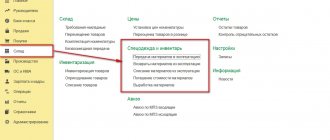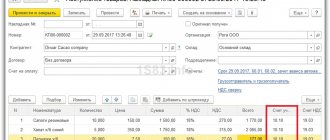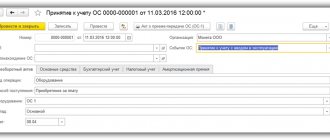Conditions taken into account when writing off workwear
From 01/01/2021, in the accounting of workwear you need to follow the rules of the new FSBU 5/2019 “Inventories”.
The guidelines for accounting of workwear (approved by order of the Ministry of Finance dated December 26, 2002 No. 135n) become invalid from this date. According to clause 3 of FSBU 5/2019, workwear is classified as inventory if its service life does not exceed 12 months.
The employee must sign for the work clothes received. To do this, you need to issue a card for issuing personal protective equipment for each employee and a statement for issuing special clothing. Samples of filling out these documents can be found in ConsultantPlus. If you do not have access to the K+ system, get a trial online access for free.
PPE accounting cards are available for free by clicking on the picture below:
For information on documenting the issuance of protective clothing, read the article “Personal record card for the issuance of personal protective equipment—fill out form.”
When writing off workwear, certain conditions are taken into account. Let's study them using a simple example.
Example
Design Remont LLC, which provides apartment renovation services, purchased clothing in May for an employee carrying out painting work:
- protective suit;
- headdress;
- gloves;
- protective glasses.
| Conditions | Protective suit | Headdress | Gloves | Protective glasses |
| Cost without VAT, rub. / PC. (a couple) | 1 290 | 320 | 130 | 960 |
| Quantity | 2 pcs. | 1 PC. | 12 pairs | 1 PC. |
| Does this apply to workwear? | Yes | Yes | Yes | Yes |
| Clause 3 FSBU 5/2019, art. 209, 212, 221 of the Labor Code of the Russian Federation, clause 40 of the order of the Ministry of Finance of the Russian Federation “On standard standards for issuing workwear in all types of activities” dated December 9, 2014 No. 997n (hereinafter referred to as standard standards No. 997n) | ||||
| Service life of workwear, months. | 12 | 12 | 2 | Until wear and tear no more than 12 months. |
| Clause 3 FSBU 5/2019, clause 40 of standard standards No. 997n + clause 9 of the order “On standard standards for issuing special clothing for repair and construction work” dated July 16, 2007 No. 477 - clarification on safety glasses | ||||
| Specifics of writing off workwear in accounting | During commissioning, on a one-time basis or during the service life | |||
| Subp. “d” clause 23, clause 43 FSBU 5/2019 | ||||
| Specifics of writing off workwear in tax accounting | During commissioning, on a one-time basis or during the service life | When commissioning, on a one-time basis (since the service life of the gloves is less than 1 reporting period) | During commissioning, on a one-time basis or during the service life | |
| Subp. 3 p. 1 art. 254 Tax Code of the Russian Federation | ||||
| What expenses are workwear included in accounting? | For production (or other - in case of early termination of production work) | |||
| Subp. “d” clause 23 FSBU 5/2019 | ||||
| What expenses are workwear included in tax accounting? | For material ones - on the basis of documentary evidence of the presence of working conditions requiring the use of special clothing and determined during their special assessment | |||
| Subp. 3 p. 1 art. 254 Tax Code of the Russian Federation | ||||
Workwear with a service life of more than 12 months must be recorded in accounting as a fixed asset (FSBU 6/2020 “Fixed assets”, valid from 2022, PBU 6/01 “Accounting for fixed assets”, valid until the end of 2022) and written off monthly order in the form of depreciation. This method is appropriate for expensive workwear - costing > 100,000 rubles. FSBU 6/2020 allows you to set any limit on the cost of fixed assets, including the same as for income tax - 100,000 rubles. And property of lesser value is immediately written off as expenses. If in accounting the limit on the cost of fixed assets is set below 100 thousand rubles, then when adding workwear worth less than the specified limit to fixed assets, you will have to reflect temporary differences between the tax and accounting accounting of workwear.
The procedure for accounting for fixed assets in accounting is regulated:
- from 2022 - FSBU 6/2020 “Fixed assets”, approved. by order of the Ministry of Finance of Russia dated September 17, 2020 N 204n;
- until the end of 2022 - PBU 6/01 and explained in the Guidelines for accounting of fixed assets, approved by Order of the Ministry of Finance of Russia dated October 13, 2003 No. 91n.
Since 2022, PBU 6/01 “Accounting for fixed assets” has become invalid; it has been replaced by two new FSBU 6/2020 “Fixed assets” and FSBU 26/2020 “Capital investments”. Find out how to set a limit on the cost of fixed assets in accounting in accordance with FSBU 6/2020 in the Ready-made solution from ConsultantPlus. Get trial access to the system for free and go to the Ready-made solution.
Working clothes when dismissing an employee: what taxes will the employee pay?
Since the workwear does not belong to the employee, but is the property of the organization that issued it, the employee must treat the uniform with care and return the set back to the company. For example, if:
- the subordinate decided to leave the company;
- the employee has moved to a new position or workplace;
- the overalls have become unsuitable for further wear (due to natural wear and tear or damage).
| The employee returned the workwear | The employee left the workwear with him or lost it |
| The workwear is transferred back to the company; the remaining cost after normal wear and tear of the uniform is reimbursed from the employee’s funds; the number of items transferred is debited from the employee’s personal card; Personal income tax is not paid. | The employee received an intangible benefit - income by keeping his clothes; the cost of workwear is subject to personal income tax, which is withheld from the employee; the tax is paid to the Federal Tax Service; the amount of income is taken into account in the certificate in form 2-NDFL when registering dismissal. |
The procedure for writing off workwear that has become unusable ahead of schedule
Example (continued)
In May, Design Repair LLC put into operation 1 protective suit, 1 headgear, 12 pairs of gloves and 1 safety glasses.
The write-off method for workwear is defined as a monthly linear write-off, with the exception of gloves - they are written off in full at one time.
After the workwear began to be used, the following events occurred:
| Period | Events | Amount of depreciation written off before damage to workwear | Amount to be written off after damage to workwear | Write-off of the remaining cost of workwear in accounting |
| September | The suit was damaged beyond repair through no fault of the employee | 430 rub. = 1,290 / 12 months × 4 months (June - September) | 860 rub. = 1,290 – 430 | Financial results |
| October | Lost hat due to employee fault | 133 rub. = 320 / 12 months × 5 months (July - October) | 187 rub. = 320 – 133 | For settlements with the employee for compensation of damages |
| November | 12 pairs of gloves were irreparably damaged through no fault of the employee | RUB 1,560 = 130 × 12 pairs | 0 rub. | Not carried out, because the cost of gloves was written off in full in May as part of production costs |
| December | The suit, put into operation in September, was sold due to the end of apartment renovation activities | RUB 322.50 = 1,290 / 12 months. × 3 months (October December) | RUB 967.50 = 1,290 – 322.50 | For other expenses |
The procedure for writing off inventories in accordance with the requirements of the new FSBU 5/2019 is described in detail in the Ready-made solution from ConsultantPlus. If you do not already have access to this legal system, trial access is available for free.
Workwear upon dismissal of an employee: how to return workwear to an employee
During the entire period of operation of the workwear, it is registered with the employee who uses it. If the service life of the kit has expired, or under the influence of external factors the uniform items have become unusable, the workwear has to be written off from the balance sheet. However, if an employee is to blame for damage or loss of clothing, he is obliged to compensate the company for losses by paying the cost of the set to the cashier in cash. It is also possible to withhold an amount from wages if the payment is made in cashless form. In this case, the accountant is required to make the appropriate entries. When writing off clothes in shares:
| DEBIT | CREDIT | Wiring |
| 10-10 | 10-11 | An employee returned a set of clothes to the company |
| 94 | 10-11 | The cost of clothing is recognized as a loss if the employee does not return it. |
| 73 “Settlements with personnel for other operations” | 94 | Loss caused by an employee who did not return clothes |
| 50, 51 | 73 | The employee transferred money for loss or damage to clothing |
| 70 | 73 | Losses were withheld from the employee's salary |
If it is customary for an enterprise to write off the cost of workwear at once, as a total amount, the following entries are made:
| DEBIT | CREDIT | Wiring |
| 73 | 91-1 “Other income and expenses” (sub-account “Other income”) | The cost of personal protective equipment is written off as an expense as a loss. |
| 50 "Cashier" | 73 | The employee returned the money for the clothes to the cash register in cash. |
| 70 “Settlements with personnel for wages” | 73 | The cost of clothing was deducted from the employee's salary |
Standards for writing off workwear in accounting and tax accounting
According to clause 14 of the order of the Ministry of Health and Social Development of Russia “Inter-industry rules for providing workers with personal protective equipment” dated 01.06.2009 No. 290n (hereinafter referred to as inter-industry rules), the write-off limit for workwear is based on standards approved either by industry acts or standard standards No. 997n.
The employer has the right to approve its own standards that increase the provision of workers with special clothing. Self-determined standards must correspond to the results of a special assessment of working conditions (clause 6 of the intersectoral rules).
Workwear is written off in accounting based on the actual costs incurred for its purchase (production).
The procedure for classifying workwear as material expenses in tax accounting is approved by the employer independently - in full on the date of commencement of its use or within several reporting periods after the start of use (subclause 3, clause 1, article 254 of the Tax Code of the Russian Federation).
The norms for the consumption of protective clothing are not fixed in the Tax Code of the Russian Federation, as well as in the accounting rules. But the position of the Ministry of Finance of the Russian Federation (letters dated 04/08/2016 No. 03-03-06/1/20165, dated 11/25/2014 No. 03-03-06/1/59763) indicates that the maximum value for attributing used workwear to tax expenses accounting should be determined by organizations on the basis of standards established by law or internal acts of the employer.
If the norms for write-off of workwear are unreasonably exceeded, permanent differences arise between the tax and accounting records of workwear.
Accounting and write-off of inventory items and workwear in 2021-2022 by postings
The first thing every practicing accountant should do is to read the accompanying documentation, and then think through and develop a policy for interaction with each type of inventory as a whole. All work is carried out according to the following approximate step-by-step scheme:
- Using FSBU 06/2020 standards, we establish the useful life of complete sets of special clothing and footwear. At this stage, the main task is to choose whether the company will consider this class of objects as inventory or not.
- We create instructions that answer the question about the use of things whose service life exceeds 12 months.
- We decide whether the financial equivalent of inventories is significant for users of the reports being developed.
- Based on the principles of rationality, we determine the type of operation of the OS: monitoring each set separately or taking into account the totality of all PPE.
As mentioned above, the new rules for writing off workwear for 12 months in 2021-2022 are far from the only changes proposed by supervisory authorities in the region in question. However, having started studying modern and modernized regulations from the proposed list, a specialist will easily work through everything, including the most difficult to understand nuances.
Accounting entries generated when writing off workwear
According to the chart of accounts approved by order of the Ministry of Finance of the Russian Federation dated October 31, 2000 No. 94n, movements in workwear are recorded on account 10, subaccounts “Workwear in warehouse” and “Workwear in use.”
For controlled accounting of used workwear, written off on a one-time basis during commissioning, you can enter an off-balance sheet account “Workwear in operation” (clause 8 of FSBU 5/2019).
Example (continued)
Design Repair LLC reflected the entries for write-off of workwear:
| Period | Actions | Dt | CT | Sum |
| May | Workwear has been received into the warehouse | 10 “Workwear in the warehouse” | 60 | RUB 5,420 = 1,290 × 2 + 320 × 1 + 130 × 12 + 960 × 1 |
| The special clothing was put into operation | 10 “Workwear in use” | 10 “Workwear in the warehouse” | 4,130 rub. =1,290 × 1 + 320 × 1 + 130 × 12 + 960 × 1 | |
| June | The wear and tear of workwear for the month is reflected | 20 | 10 “Workwear in use” | 214 rub. = 1290/12 + 320/12 + 960/12 |
| The cost of gloves has been written off | 20 | 10 “Workwear in use” | RUB 1,560 = 130 × 12 | |
| The cost of gloves is reflected on the balance sheet | 012 “Workwear in use” | — | RUB 1,560 | |
| September | The residual value of the suit has been written off | 94 | 10 “Workwear in use” | 860 rub. |
| 91 | 94 | 860 rub. | ||
| October | The residual value of the headdress has been written off | 94 | 10 “Workwear in use” | 187 rub. |
| 73 | 94 | 187 rub. | ||
| November | The cost of gloves has been written off from the balance sheet | — | 012 “Workwear in use” | RUB 1,560 |
| December | The residual value of the sold suit has been written off | 91 | 10 “Workwear in use” | RUB 967.50 |
How to take into account workwear
It is easiest to explain the rules for monitoring and inventory of this class of inventory using an example in which the monitored object belongs to the category of reserves. So, the procedure will be as follows:
- Debit 10.10 and Credit 60 – receipt.
- D 20 (25, 44, etc.) and K 10.10 – commissioning.
- D MC.02 – The cost of addressed items is taken onto the balance sheet.
In addition, action schemes are separated (the kit has temporarily deteriorated or the employee for whom it was actually intended has quit). This section of commodity accounting operations is described in detail in clause 7.4 of PBU 1/2008.
Changes in accounting for workwear from 2021-2022, depending on the purpose of use, are given exclusively in the regulations of FSBU 06/2020; previous forms of law enforcement simply do not contain new calculations and rules. To avoid confusion when comparing modern standards and old calculations, an accountant can use, for example, specialized software. The mobile module “Warehouse-15” (or “Store-15”), for example, already includes all the necessary modifications, including the area in question.
Results
The procedure for recording the write-off value of workwear depends on the period of its operation and the reasons for write-off - on a one-time basis or during the service life;
for production (or other) expenses or for settlements with guilty parties. Standards established by law or internal documents of the organization regulate the write-off limit for workwear in tax accounting. You can find more complete information on the topic in ConsultantPlus. Free trial access to the system for 2 days.







